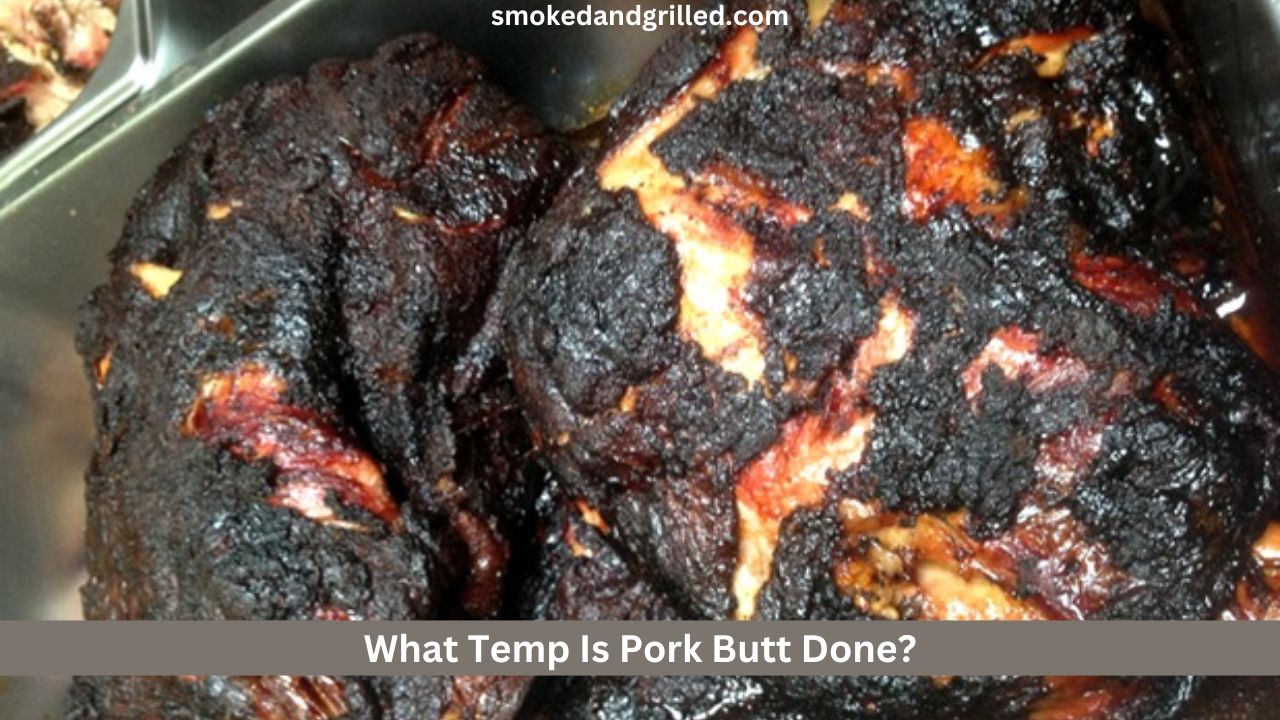Are you confused by the various temperature recommendations for pork butt?
With different cooking methods available, it cannot be easy to decide when your roast is done.
But don’t worry – we’re here to clear up any confusion and show you how to determine if your pork is cooked through quickly.
Eating undercooked pork isn’t advised since parasites and bacteria can thrive in raw or undercooked meat.
To ensure your dish is cooked correctly, use a digital food thermometer inserted into the thickest part to get an accurate reading—ideally aiming for around 200°F once done.
We’ll also discuss why preparing an adequately cooked pork butt is essential and provide tips for getting it right every time.
So read on for everything you need to know about the perfect temp for a done pork butt!
What Temp Should Pork Butt Be?
Cooking pork butt to the correct temperature is essential for flavorful and juicy results.
This is a minimum temperature requirement set by the USDA Food Safety and Inspection Service to ensure any harmful bacteria are destroyed.
This will provide the fork-tender texture that makes good ‘que great! For optimal safety and deliciousness, ensure your meat thermometer reads at least 145 degrees before taking that pork butt off the heat!
Also Read: Boston Butt Vs Pork Butt- Which One Is Best?
Why Is It Called A Pork Butt?
Have you ever wondered why the cut of meat used to make the infamous pulled pork sandwich is called a ‘pork butt’?
As it turns out, a pork butt has nothing to do with pigs’ anatomy.
‘Butt’ refers to the packing barrel it was historically stored in.
The barrel is known as a ‘butt’ because it resembles a cask or ‘butte’ holding wine or beer. So next time you savor your juicy carrier of smoky barbecue, wonder why it is called a pork butt!
Cook To Time Or Cook To Temp?
There is some debate regarding the appropriate temperature; I’ve read references to everything from 180 degrees Fahrenheit to 205 degrees Fahrenheit.
I aim for a pulled pork internal temperature of 205 degrees Fahrenheit, and I check the temperature in multiple spots before declaring it done (it’s challenging to get a good consistent read on pork because gobs of fat can throw off the reading).
Depending on the size of the pig butt, I might only cook it to 190 degrees Fahrenheit. I rely more on my gut feelings than I do on my Polder.
I advise scheduling an additional one and one-quarter hours per pound, but you shouldn’t do this haphazardly.
When I’m halfway through my estimate, I start checking mine and continue to monitor it while sweeping it or mopping it.
I’ve seen rates as low as one hour per pound and as high as two and a half hours per pound… yeah, that’s genuinely the case.
For your information, with my Model 150 (my huge one, guys), I’ve done as many as eight butts, and it takes approximately 1.5 hours per pound on average.
On average, each of these weighed somewhere between 12 and 14 pounds.
An Observation Regarding The Plateau.
It’s impossible to say how long this will go on; it may be 45 minutes, or it could go on for two hours.
When I’ve been at it for a while and reached my goal, I’ll turn the cooker up to 250 degrees Fahrenheit. Keep in mind that everything is finished when it is finished.
To Foil Or Not To Foil.
Even though I’m not a fan of foil, I have to admit that it does an excellent job of preventing moisture loss.
My grievance is that I would like some of the “famous Mr. Brown” bark with my butt, but you can’t get that with foil since it is too “mushy.”
Now that they are about done, I wrap them in foil to keep them moist and then throw them on the grill for about ten to fifteen minutes so the outside can get charred.
Tips And Tricks For Cooking Pork Butt
- Pork butt is a tough cut of meat that benefits from slow, wet cooking methods like braising or stewing.
- To help tenderize the meat, you can marinate it overnight in olive oil, vinegar, garlic, and herbs.
- When ready to cook, sear the pork butt in a hot pan to brown the exterior before adding it to your chosen cooking method.
- Braising is a good option for tough cuts of meat like pork butt as it helps to break down the connective tissues and makes the meat more tender.
- To braise pork butt, sear it in a hot pan, add it to a pot or slow cooker with some liquid (like chicken stock or water) and cook it on low heat for several hours.
- Another option for cooking pork butt is to Stew it. This method is similar to braising but uses less liquid to cook the meat in more of its juices.
- To stew pork butt, sear it in a hot pan, then add it to a pot or Dutch oven with just enough liquid to cover the bottom of the pool. Cook on low heat for several hours until the meat is very tender.
- Roasting is another option for cooking pork butt, but because this cut of meat is so tough, it’s best to roast it at a lower temperature than you would other cuts of pork.
- To roast pork butt, sear it in a hot pan, then place it in a roasting dish or baking sheet and roast at pulled pork internal temperature of 205 degrees Fahrenheit for several hours until the meat is very tender
FAQs
1- What Temp Is Pork Shoulder Done Smoking?
If you’re planning to smoke pork shoulder, the internal temperature must reach between 200 and 205 degrees Fahrenheit.
By checking the internal temperature, you can be sure your pork shoulder will be cooked through for a tender, juicy result!
2- What Temp Is Pork Boston Butt Done?
The Food and Drug Administration recommends that whole cuts of pork, such as the Boston butt, reach an internal temperature of 195 degrees Fahrenheit before eating.
When your thermometer indicates the meat has reached this temperature, remove it and allow the roast to rest for 3 minutes before serving.
Final Thoughts
It doesn’t matter how large or little a piece of pork butt you have; the internal temperature needs to be at least 195 degrees Fahrenheit before it can be considered well-cooked.
Aiming towards the number 200 rather than 100 is a more intelligent move because it’s simpler to keep in mind.
If you can keep this in mind, moving forward shouldn’t present any difficulties.
Also Read: How Long To Smoke A 5 Lb Pork Butt? (Tips & Guides)



